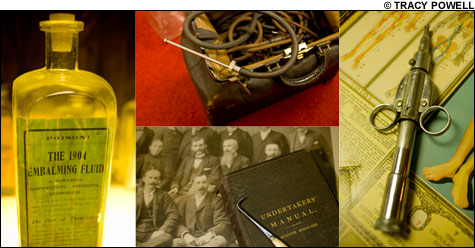
PAST/PASSED: Situated somewhat unceremoniously in the basement of Dodge Chemical Co.’s Cambridge headquarters is an unpolished gem of a mortuary museum, open to the public (by appointment only). |
Married to the morgue
Funeral directors often compare the act of making funeral arrangements to the act of planning a wedding — but one in which they often have less than a week to pull everything together, instead of the Bridezilla-requisite one year. (Plus, instead of a tuxedo, the bridegroom wears a shabby black cape and carries a scythe.)
In a typical instance, a funeral director might be called upon to transfer a body from its place of expiration; embalm and prepare the body for viewing by flushing out stagnant blood and pumping it full of preservatives; counsel the grieving family; design a personalized service; coordinate with clergy, musicians, florists, and drivers; prepare and distribute an obituary; procure a death certificate; notify the Social Security Administration of the deceased's passing; and help arrange for the transfer of pensions and insurance policies.
The physical aspects of the job, historically, have been obstacles for women. Not because chicks can't haul a cadaver down a flight of stairs and then slice it open and snip rotting veins and arteries without crying and gagging at the sight of exposed muscle tissue, but because men have always assumed that they can't.
"Funeral service in America is largely white, mature-male dominated," says Jacquelyn Taylor, the executive director of NEI. "It's similar to what we used to think about when we thought of physicians. It's no longer true in medicine, but that took a pretty long time for that to be the case. Interestingly enough, women have always been in funeral service, but the men were the business owners, the face of funeral service, whereas their spouses — and, later on, their female employees — were the support staff."
Taylor, like Peterson, experienced a "calling" to the industry at a young age; her family lived next to a funeral home, and a brazen 10-year-old Taylor knocked on its door as a dare. Once she caught a glimpse inside, Taylor was hooked. She spent nearly 30 years working as a funeral director and (the first female) branch manager of Uniservice Corporation, owner of mortuaries and cemeteries in the Pacific Northwest. She came to Mount Ida College in 2001.
Taylor describes three primary barriers that have traditionally prevented women from advancing in the funeral-service industry: a perception that they had physical limitations; a perception that they did not have the emotional suitability; and the perceived "danger" of a woman working in close quarters with a man who is not her husband. (Nothing like a corpse to ignite corporeal lust.) "Now, in the 21st century, we may scoff at that, but those were very real concerns for a long time," says Taylor. "They were artificial barriers, but they were persistent. And that is just utter nonsense — the idea that people can't work together and not control their animalistic urges."
As seen on TV
Urges of a more cerebral nature have attracted many young women to the funeral industry; namely, the urge to help distressed mourners navigate one of the more difficult milestones of life. Dealing with the death of a loved one can be facilitated by a competent and sympathetic funeral director. "The perception of the general public is that women tend to be more compassionate," says Dr. Lyn Prendergast, founder (with her husband, Dr. Louis Misantone) of FINE. "A lot of women do have compassionate sides, and I think it's one factor that draws them into the industry, but it shouldn't be a blanket statement. Unfortunately, though, it's mostly true."
The success of pop-entertainment phenomena like HBO's Six Feet Under (2001–2005) — featuring an adorable Lauren Ambrose — and A&E's funeral-home reality series Family Plots (2004) has helped, too, by demystifying (de-creep-ing?) the stereotypes often associated with funeral direction: oil-slick comb-overs, impossibly erect posture, cheap black suits, and eerily wringing hands. And, though it's unfortunate that television was an impetus for gender empowerment, once young women had "normal" funeral-service role models to identify with, it became easier to reconcile pursuing funeral service as a career.
Still, the reality of funeral service has none of the existential angst of Six Feet Under.
Plenty of women are attracted to funeral service simply because, like Peterson, they want to help those in need. Maybe, for some, this is an extension of some inherent "Mommy" impulse. For others, like Lindsay Lincoln, 19, this desire to manage crises is prompted by experience. "In high school, three of my best friends' fathers died tragically," says Lincoln, a student at NEI who also works in the customer-service division of Dodge Chemical Company, one of the world's premier distributors of embalming chemicals, located right by the Alewife MBTA station in Cambridge. (It is also home to a collection of funeral-oriented oddities in its basement. See photo above.) "I was always around funerals and wakes, always helping my friends. I thought, what better way to give back to people and help them then go into this field?"